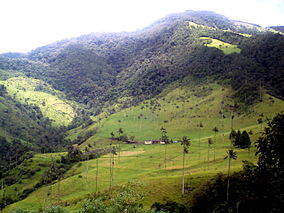- Cocora valley
-
For the Romanian commune, see Cocora, Ialomiţa.
Cocora Valley
View of Cocora ValleyLocation Quindío Nearest city Salento Coordinates 4°55′N 76°2′W / 4.917°N 76.033°WCoordinates: 4°55′N 76°2′W / 4.917°N 76.033°W Established September 1985 Visitors 150,000[citation needed] (in a recent year) Governing body Parques Nacionales Naturales de Colombia The Cocora valley (Spanish: Valle de Cocora) is a valley in the department of Quindío in the country of Colombia. It is located in the Central Cordillera of the Andean mountains. "Cocora" was the name of a Quimbayan princess, daughter of the local chief Acaime, and means "star of water" (Spanish: estrella de agua).[1] The valley is part of the Los Nevados National Natural Park, incorporated into the existing national park by the Colombian government in 1985. It is the principal location of the national tree and symbol of Colombia, the Quindío wax palm (Ceroxylon quindiuense), as well as a wide variety of other flora and fauna (some endangered), all of which are protected under the Park's national status. The valley and the nearby town of Salento are among the most popular tourist destinations in Colombia.
Contents
Location
The Cocora valley is the valley of the upper reaches of the Quindío River, the principal river of the department of Quindío, located at an altitude between 1800 and 2400 meters. The valley is approximately 24 km north-east of the departmental capital Armenia, and accessed via a turn-off from the Armenia-Pereira highway, running via Boquia to the town of Salento. Vehicles (either private cars or jeep taxis from Salento) can then travel 11 km further on up into the valley as far as "Cocora", a collection of campsites and restaurants - other parts of the valley can only be accessed either by hiking on the numerous trails or on horseback.
The Cocora valley is part of a larger national park, the Los Nevados National Natural Park (Spanish: Parque Nacional Natural de Los Nevados). The Park covers an area of 58,000 hectares (580 km2) in total,[2] including the north-eastern part of Quindío.
History of the valley's protection
To prevent exploitation of the wax palm and the threat against the endemic species dependent on the palm, mainly due to the celebrations of Palm Sunday, the government of Belisario Betancur proposed the creation of a wildlife sanctuary and the preservation of the wax palm as the national symbol of Colombia. Law 61 of 1985 was ratified on 16 September 1985[3] with the following terms:
- "1. The species with the scientific name ceroxylon quindiuense and commonly known as the wax palm is declared to be the national tree and symbol of Colombia."
- "2. In strict accordance with the plans and development programmes the National Government is authorized carry out the corresponding financial transactions, to obtain loans, and to sign the necessary contracts, for the purpose of acquiring land in the Central Cordillera which is not owned by the nation, to create one or more national parks or wildlife sanctuaries with the purpose of preserving this national symbol and maintaining its natural environment."
- "3. The felling of the wax palm tree is forbidden and punishable with a fine, which may be converted into arrest in the municipality where the infraction was committed, in accordance with the Decree-Law 2811 of 1974."
- "4. This Law takes effect from the date of its sanction."
Climate
The Cocora valley is characterized by its temperate weather, due to its altitude. The prevailing westerly winds from the Pacific Ocean are stopped by the Andean mountains, creating a humid environment favorable to the growth of cloud forest at higher altitudes: rain falls almost daily. Temperatures vary dramatically, even within one day. The average annual temperature is 15 °C, with a maximum of 25 °C and a minimum of -2 °C.
Flora and fauna
The valley is the location of the majority of the remaining populations of the wax palm (Ceroxylon quindiuense). Other flora and fauna that may be found in the valley include:[1]
Flora
- pino romeron (Dissocarpus rospigliosi)
- sietecueros (Tibouchina lepidota)
- encenillo (Weinmannia tormentosa)
- arnica
- frailejones (espeletia)
- puya
Fauna
- mountain tapir (Tapirus pinchaque)
- spectacled bear (Tremarctos ornatus)
- puma (Puma concolor)
- sloths
- yellow-eared parrot (Ognorhynchus icterotis)
- black-billed mountain-toucan (Andigena nigrirostris)
- Andean guan (Penelope montagnii)
- Andean condor (Vultur gryphus)
- hummingbirds (Trochilidae)
3 km north-east of "Cocora" up a dirt track is the finca "La Montaña" where there is a nursery for the wax palm.[4]
5 km east of "Cocora" along a trail that may be accessed on foot or on horseback is the Acaime Natural Reserve. The reserve contains 6 to 8 species of hummingbirds as well as other birds and wildlife, as well as a visitor center and restaurant.[4]
Tourism
The Cocora valley is a very popular tourist destination in Colombia. The majority of visitors make day visits from Salento, or come for the extensive camping and hiking opportunities in the valley and the National Park. Other common activities are bird watching, mountain biking, horse riding, rafting, scenic flights, and swimming in the rivers. The local restaurants specialize in cooking locally-farmed freshwater trout in several ways, mainly baked and served in a variety of sauces with patacones (plantain fritters).
External links
- Parque Natural Valle de Cocora website
- "Parques Nacionales Natural de Los Nevados" pages on Parques Nacionales Naturales de Colombia website (in Spanish and English)
- Turiscolombia website (in Spanish and English)
References
- ^ a b Official website of the Cocora valley
- ^ "Parque Nacionales Natural de Los Nevados" page on Parque Nacionales Naturales de Colombia official website
- ^ Decree-Law 61 of 1985 (in Spanish)
- ^ a b Devereaux, Charlie (Jan 2009). Colombia Handbook (3rd ed.). Bath: Footprint Handbooks Limited. p. 266. ISBN 9781906098223.
Categories:- Biodiversity hotspots
- Protected areas of Colombia
Wikimedia Foundation. 2010.


